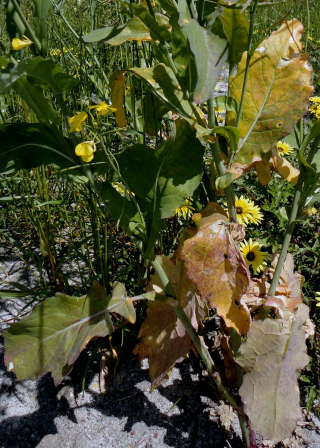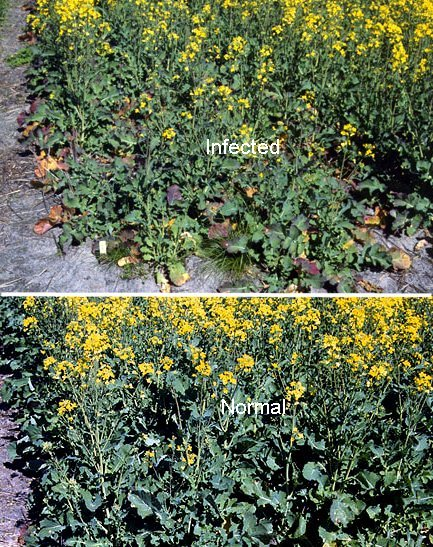TuYV infection prior to stem elongation can cause up to 50% yield losses. For every one per cent increase in the level of TuYV in a canola crop, there is a 6-12 kg/ha decline in yield resulting from formation of fewer pods and seeds. In addition to yield losses, TuYV infection diminishes seed quality by decreasing oil content and increasing erucic acid and glucosinolate levels. If the crop is infected after stem elongation, yield and quality losses are minimal.
What to look for
Paddock
- Symptoms can be inconsistent for TuYV and ‘symptomless’ infection may occur that still causes losses.
- Under certain conditions, discoloured and stunted plants that occur in patches, in thinner crop areas or the edge of the paddock, and gradually spread.
Plant
- First signs are red, yellow or purple colours at the ends or edges of older leaves, then yellowing in the middle of the leaf.
- Colours are more intense between leaf veins and on the upper side of the leaf.
- Petioles and leaf veins are green or pale.
- Discoloured leaves become thickened and may cup inwards.
- Infected are often stunted and pale, and produce few flowers or seeds.
- Late infected plants show leaf symptoms but are not stunted and have lower yield loss.
Proactive management - TuYV early warning system
- Generally, once symptoms have been observed and correctly diagnosed as TuYV infection, it is usually too late to intervene.
- Consultants can deploy yellow sticky traps to the fenceline during the early part of the growing season and send them into DDLS (refer to Turnip yellows virus early warning system).
- Any aphids caught are tested for TuYV using a sensitive detection technique called ‘LAMP’.
- This can provide detection of the virus in the environment before it reaches uncontrollable levels in the crop, and inform decisions on insecticide application.
What else could such symptoms be?
| Condition | Similarities | Differences |
| Purple red colours spreading down from the ends of oldest leaves | However nitrogen deficient plants are smaller and thinner rather than stunted. Paddock distribution varies according to soil type rather than in patches or edges. | |
| Reddish mottling of older leaves | However herbicide damage causes discolouration and distortion of emerging leaves, and multiple growing points | |
| Reddish mottling of older leaves | However herbicide damage causes discolouration and distortion of emerging leaves, and multiple growing points |
Where did it come from?
- TuYV is regularly found in high and medium rainfall grainbelt zones but can also occur in low rainfall zones.
- It is not seed-borne, but survives in weeds or volunteer canola host plants outside the growing season and is spread from these infected plants into crops by aphids which act as vectors for virus transmission.
- The main source of TuYV for canola crops is infected wild radish weeds growing along fence lines and road verges or volunteer canola. Other weed hosts include wild melon, fleabane, stinkweed, soursob, marshmallow and blackberry nightshade. It also persists year-round in infected lucerne pastures and some native legume species.
- It also infects other crop and pasture species including mustard, chickpea, lupin, lentil, faba bean, field pea, lucerne, medic and subterranean clover.
- Green peach aphid is the principle vector for early, damaging spread, but cabbage aphid acts as a minor vector in late infections.
- TuYV is transmitted persistently. When an aphid feeds on an infected plant it acquires the virus permanently. When the infective aphid then probes the phloem of a healthy plant it infects the plant and continues transmitting TuYV for the rest of its life.
- Autumn is the most critical infection period, so the earliest-sown crops are most vulnerable when conditions for autumn aphid activity is conducive.
Management strategies
Pre-sowing to sowing time
- Surveillance for viruliferous aphids using yellow sticky traps.
- Control broadleaf weeds (especially over summer) as they act as reservoirs for the viruses.
- Retain stubble at sowing to cover the ground, this reduces the ability of aphids to land on young canola plants thereby reducing virus spread.
- Manipulate sowing dates. Delay sowing to avoid exposure of young canola seedlings to peak aphid flights.
- Sow at high seeding rates. High plant density helps diminish the rate of virus spread and speeds up canopy closure resulting in lower aphid landing rates.
- Use insecticide seed treatment. Neonicotinoid seed treatment applied effectively can provide early control of green peach aphid vectors during the vulnerable seedling growth stage. However to achieve effective control it is important to ensure that sufficient insecticide coats each seed.
Post sowing
- Application of sulfoxaflor (Transform), flonicamid (MainMan) or afidopyropen (Versys ®) during rosette phase to reduce initial green peach aphid infestation, prevent widespread colonisation of the crop and may prevent high incidence of TuYV infection. For more information refer to Insecticide spray guides for crops in Western Australia.
- Note: Pirimicarb, organophosphate and synthetic pyrethroid insecticides are likely to ineffective against green peach aphids because of widespread insecticide resistance.



